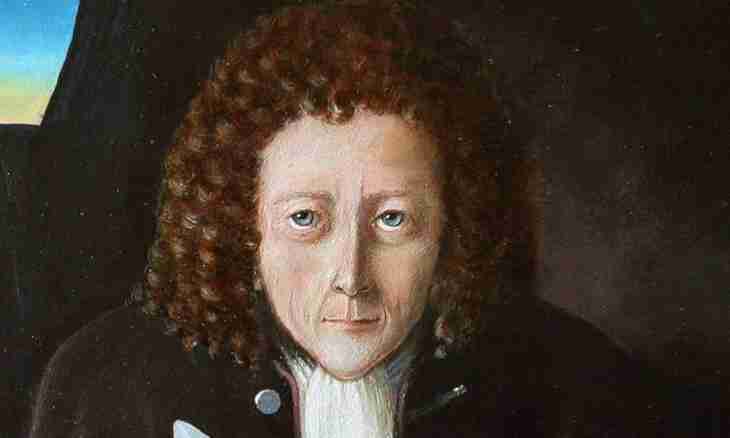In the 17th century England became epicenter of scientific revolution - new methods of a research, courageous hypotheses and sensational experiments forever changed understanding of mankind of the world around. Among the first scientists who tamed the nature in laboratory there was Robert Boyle - the aristocrat who refused burning of life in favor of science.
LIFE AND CAREER
Robert Boyle is a pioneer and the founder of modern chemistry, one of founding fathers of physics, the philosopher-theologian. The contemporary and the senior predecessor of Isaac Newton, Robert Hooke's mentor, Boyle stood at the origins of classical experimental science.
Boyle was born in the Irish lock Lismore on January 25, 1627. The seventh son of count of Korksky was free in the choice of a course of life. On traditions of that time, primary education he received houses, then studied in Eton. In 12 years Boyle left the house and went behind knowledge to Europe. After the death of the father Robert got solid inheritance, and he settled on the homeland in the estate Stelbridge. Studying philosophy and divinity, Boyle like Francis Bacon's empiricism: the philosophical system advanced for those times suggested scientists to use induction and an experiment instead of spontaneous observations.
In the 40-50th years Robert was a naturalistic philosophy representative as a part of Hidden Board. In 27 years the gifted scientist became one of founders of Society of Sciences – future London Royal society which headed subsequently. Boyle also directed the East Indian company.
He never married, having put all means and heart and soul in occupation science and philosophy. Died in London on December 31, 1691, having lived 64 years, productive and long for the century.
CONTRIBUTION TO SCIENCE
Robert Boyle founded own laboratory in Oxford in the 1654th year. As it is necessary to the pioneer, he was engaged in several fields of the arising new science. The era of the mathematical analysis and physical formulas began. In the 1662nd year Boyle made fundamental discovery: pressure of some mass of gas at an invariable temperature in inverse proportion to its volume. For example, if to double pressure, gas exactly in so many time will decrease in volume.
Four years later the same dependence the French scientist Edme Marriott reopened. Today Boyle-Mariotta's law - an obligatory part of the school program in physics. Experimenting with recently invented by Otto von Gerike to air pumps, Boyle determined the specific weight of air; found boiling of water in the rarefied environment and susceptibility of smoke to terrestrial inclination; recorded allocation of energy at friction; explained a capillarity with the movement of liquid in rarefied air. In laboratory the scientist proved that water extends when freezing, and ice evaporates.
Boyle joined the advanced researches of electricity and magnetism. The brilliant experimenter to Newton conducted optical experiments, having drawn a conclusion on the corpuscular nature of light and that all colors turn out in interaction of white light with the surfaces of bodies; opened color rings in thin layers (today they are called Newtonian).
Boyle theorist drew on atomic the structure of bodies. Having much more outstripped the time, he predicted detection of atoms at consecutive decomposition of bodies, explained three conditions of substance with differences in the speed of the movement of particles.
If in physics Boyle marched in step contemporaries, then in chemistry made a revolution, having made it science and having put on experimental rails. In the book "Chemist sceptic" (1661) he laid the foundation of division of chemistry and pharmaceutics, rejected alchemy and began to use a concept of chemical element of modern understanding.
Many conclusions of the first chemist were naive, but faultlessly made experiments became invaluable material for future generations. We are obliged to Boyle qualitative and quantitative by research methods. On the basis of its experiments with metal burning Lomonosov and Lavoisier opened the fundamental mass conservation law. Boyle, being the convinced atomist, explained increase in mass of metal when roasting with absorption of corpuscles of fire. He was narrow-minded from the truth: actually scale - result of connection with oxygen atoms.
The reason of scientists of the age of Enlightenment managed wonderfully to combine incompatible. Robert Boyle - not only the scientist-scientist, but also the theologian. In youth he was so religious that, having doubted fundamentals of Christianity, nearly committed suicide. Robert approached strengthening of belief with the sequence, usual for himself: learned the Greek and Jewish languages for reading the Bible in the original. It personally translated the Sacred Writing into the Celtic languages, founded Christian missions in India and annual readings about god and religion – "Boyle's Lectures". They were read by 213 years in a row and renewed in the 2004th year.
